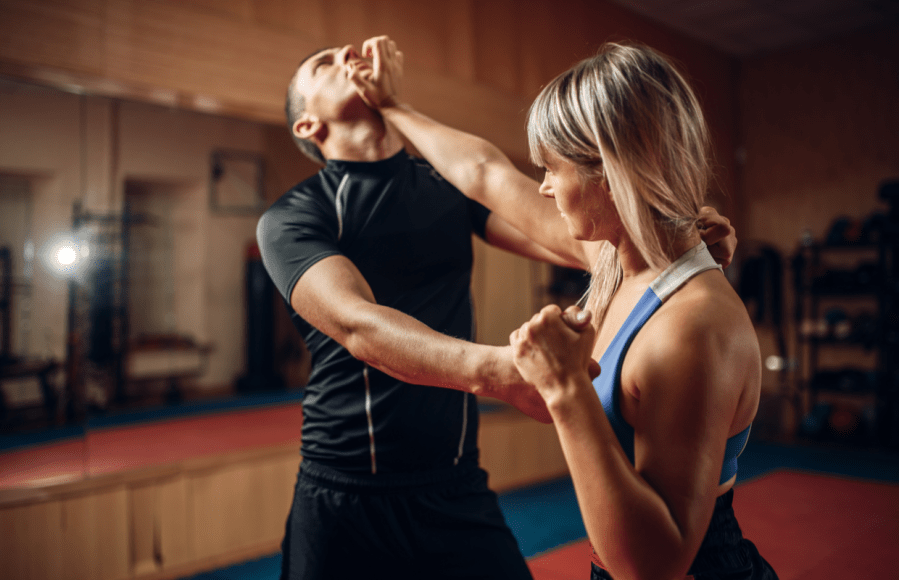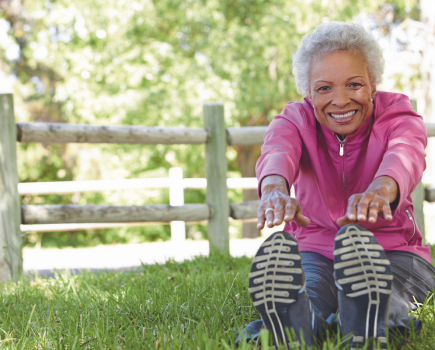Learning a few simple self-defence moves and techniques will help you feel safer on the streets – and give you a workout!
With reports of violence against women increasing at an alarming rate, many of us are feeling anxious about walking alone – especially at night. And while the answer to ending this violence shouldn’t lie in a woman’s ability to defend herself, getting to grips with some easy and simple self-defence moves can give you more confidence when walking at night. Plus, it will also improve your strength, flexibility and balance.
What does self-defense involve?
When you think of self-defence, you probably imagine martial arts training. But in reality it’s much more about functional movement than fancy kicks and punches.
‘We basically cherry pick the best bits of different martial arts and make them more practical. It’s a holistic way of training and there are so many real-life benefits from learning to move better,’ says Reece Coker, chief instructor at Combat Academy.
‘What’s more, when you’re engaged in learning a new skill it’s incredible how long you can keep going for without noticing. You enter a flow state where you’re immersed and leave feeling energised – you don’t get that from the treadmill.

Why you should learn self-defense
The first rule of self-defence is to avoid dangerous situations in the first place. ‘Think of your awareness as a traffic light system,’ says Reece ‘Most of us are on green when we walk around – we’re oblivious and distracted. We don’t want to be on red, feeling terrified, but it makes sense to aim for amber, where we have an awareness of the situation we’re in – it’s just a slight shifting of mindset.’
Ultimately though, try not to be too anxious. ‘We obviously hope you’ll never be attacked, and statistically you probably never will be,’ says Reece. Learning self-defence is really just a way to help you feel your most powerful, confident self.
‘Flexibility and the ability to wriggle away is almost more important than strength when it comes to defence. Regular yoga or Pilates will strengthen your core and keep you flexible.’ – Reece Coker, chief instructor at Combat Academy
3 simple self-defense moves and techniques
While much of what you’d learn in a simple self-defence class involves strategies for getting to safety rather than specific moves, there are things you can work on to help you stay ready for anything.
1. Create distance
An important element for staying safe is keeping a distance between you and a potential attacker. Practise facing one direction and bouncing on your toes, going forward, backwards and side to side as quickly as you can, with your hands out in front of you in a ‘stop’ gesture.
This is a great move for strengthening your calves, ankles, legs and hips, as well as improving general mobility. It also works as a great warmup to any other exercise you do. If you have a friend to train with, you could face one another and take turns trying to ‘tag’ each other.
2. Keep moving
‘Often when people imagine defending themselves it’s from a standing position, but in reality the ground could be slippery, you might be wearing heels and you could easily fall while running,’ says Reece.
Practise getting up as fast as possible from different positions. This is a full body workout in itself! Try 10-20 quick repetitions from lying on your back, stomach and side and you’ll really get your heart rate up.
3. Get squatting
When it comes to strength, our secret weapon is our lower body, so rather than punching, think about a well-aimed kick. ‘Women’s legs and hips are stronger proportionately than men’s, so it makes sense to keep them working hard. Do lots of squats and lunges,’ says Reece. Strong legs will also help you run fast if needed.

Further training…
Interested in upping your self-defense skills by trying pure martial arts? Here are a handful of the different styles…
Best for mental clarity: Judo
Designed to train body and mind, judo involves both standing and groundwork helping to pin down opponents. There’s no kicking, punching or striking involved.
Best for cardio: Karate
This uses lots of striking techniques using hands and feet to deliver blows.
Best for defence: Jiu Jitsu
Using your opponent’s energy against them, in Jiu Jitsu you neutralise them by pinning or throwing them, with mostly groundwork.
Best for weight loss: Muay Thai
This focuses on eight points of contact and uses punches, kicks, knee and elbow strikes while staying on your feet.







